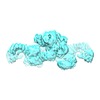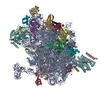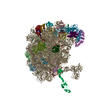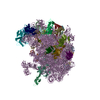[English] 日本語
 Yorodumi
Yorodumi- EMDB-3213: Architecture of human mTOR Complex 1 - 5.9 Angstrom reconstruction -
+ Open data
Open data
- Basic information
Basic information
| Entry | Database: EMDB / ID: EMD-3213 | |||||||||
|---|---|---|---|---|---|---|---|---|---|---|
| Title | Architecture of human mTOR Complex 1 - 5.9 Angstrom reconstruction | |||||||||
 Map data Map data | Human mTOR complex 1 MTORC1 MTORC1 | |||||||||
 Sample Sample |
| |||||||||
 Keywords Keywords |  Rapamycin / TOR / Rapamycin / TOR /  mTOR / Raptor / mTOR / Raptor /  mLST8 / mLST8 /  FKBP / FKBP /  mTORC1 mTORC1 | |||||||||
| Function / homology |  Function and homology information Function and homology informationRNA polymerase III type 2 promoter sequence-specific DNA binding / positive regulation of cytoplasmic translational initiation / RNA polymerase III type 1 promoter sequence-specific DNA binding / positive regulation of pentose-phosphate shunt / T-helper 1 cell lineage commitment / regulation of locomotor rhythm / positive regulation of wound healing, spreading of epidermal cells / cellular response to leucine starvation / TFIIIC-class transcription factor complex binding /  TORC2 complex ...RNA polymerase III type 2 promoter sequence-specific DNA binding / positive regulation of cytoplasmic translational initiation / RNA polymerase III type 1 promoter sequence-specific DNA binding / positive regulation of pentose-phosphate shunt / T-helper 1 cell lineage commitment / regulation of locomotor rhythm / positive regulation of wound healing, spreading of epidermal cells / cellular response to leucine starvation / TFIIIC-class transcription factor complex binding / TORC2 complex ...RNA polymerase III type 2 promoter sequence-specific DNA binding / positive regulation of cytoplasmic translational initiation / RNA polymerase III type 1 promoter sequence-specific DNA binding / positive regulation of pentose-phosphate shunt / T-helper 1 cell lineage commitment / regulation of locomotor rhythm / positive regulation of wound healing, spreading of epidermal cells / cellular response to leucine starvation / TFIIIC-class transcription factor complex binding /  TORC2 complex / heart valve morphogenesis / TORC2 complex / heart valve morphogenesis /  regulation of membrane permeability / negative regulation of lysosome organization / RNA polymerase III type 3 promoter sequence-specific DNA binding / regulation of membrane permeability / negative regulation of lysosome organization / RNA polymerase III type 3 promoter sequence-specific DNA binding /  TORC1 complex / positive regulation of transcription of nucleolar large rRNA by RNA polymerase I / calcineurin-NFAT signaling cascade / TORC1 complex / positive regulation of transcription of nucleolar large rRNA by RNA polymerase I / calcineurin-NFAT signaling cascade /  regulation of autophagosome assembly / TORC1 signaling / positive regulation of odontoblast differentiation / voluntary musculoskeletal movement / regulation of osteoclast differentiation / positive regulation of keratinocyte migration / cellular response to L-leucine / MTOR signalling / Amino acids regulate mTORC1 / cellular response to nutrient / energy reserve metabolic process / Energy dependent regulation of mTOR by LKB1-AMPK / nucleus localization / ruffle organization / protein serine/threonine kinase inhibitor activity / negative regulation of cell size / cellular response to osmotic stress / positive regulation of osteoclast differentiation / enzyme-substrate adaptor activity / regulation of autophagosome assembly / TORC1 signaling / positive regulation of odontoblast differentiation / voluntary musculoskeletal movement / regulation of osteoclast differentiation / positive regulation of keratinocyte migration / cellular response to L-leucine / MTOR signalling / Amino acids regulate mTORC1 / cellular response to nutrient / energy reserve metabolic process / Energy dependent regulation of mTOR by LKB1-AMPK / nucleus localization / ruffle organization / protein serine/threonine kinase inhibitor activity / negative regulation of cell size / cellular response to osmotic stress / positive regulation of osteoclast differentiation / enzyme-substrate adaptor activity /  anoikis / cardiac muscle cell development / positive regulation of transcription by RNA polymerase III / negative regulation of protein localization to nucleus / anoikis / cardiac muscle cell development / positive regulation of transcription by RNA polymerase III / negative regulation of protein localization to nucleus /  regulation of myelination / negative regulation of calcineurin-NFAT signaling cascade / regulation of myelination / negative regulation of calcineurin-NFAT signaling cascade /  Macroautophagy / Macroautophagy /  regulation of cell size / negative regulation of macroautophagy / lysosome organization / positive regulation of oligodendrocyte differentiation / protein kinase activator activity / positive regulation of actin filament polymerization / positive regulation of myotube differentiation / behavioral response to pain / regulation of cell size / negative regulation of macroautophagy / lysosome organization / positive regulation of oligodendrocyte differentiation / protein kinase activator activity / positive regulation of actin filament polymerization / positive regulation of myotube differentiation / behavioral response to pain /  TOR signaling / oligodendrocyte differentiation / mTORC1-mediated signalling / germ cell development / Constitutive Signaling by AKT1 E17K in Cancer / TOR signaling / oligodendrocyte differentiation / mTORC1-mediated signalling / germ cell development / Constitutive Signaling by AKT1 E17K in Cancer /  social behavior / cellular response to nutrient levels / CD28 dependent PI3K/Akt signaling / positive regulation of phosphoprotein phosphatase activity / positive regulation of translational initiation / neuronal action potential / HSF1-dependent transactivation / positive regulation of TOR signaling / positive regulation of G1/S transition of mitotic cell cycle / positive regulation of epithelial to mesenchymal transition / social behavior / cellular response to nutrient levels / CD28 dependent PI3K/Akt signaling / positive regulation of phosphoprotein phosphatase activity / positive regulation of translational initiation / neuronal action potential / HSF1-dependent transactivation / positive regulation of TOR signaling / positive regulation of G1/S transition of mitotic cell cycle / positive regulation of epithelial to mesenchymal transition /  regulation of macroautophagy / regulation of macroautophagy /  endomembrane system / 'de novo' pyrimidine nucleobase biosynthetic process / positive regulation of lipid biosynthetic process / response to amino acid / positive regulation of lamellipodium assembly / phagocytic vesicle / heart morphogenesis / regulation of cellular response to heat / cytoskeleton organization / cardiac muscle contraction / positive regulation of stress fiber assembly / T cell costimulation / cellular response to amino acid starvation / cellular response to starvation / protein serine/threonine kinase activator activity / positive regulation of endothelial cell proliferation / positive regulation of glycolytic process / negative regulation of autophagy / response to nutrient levels / post-embryonic development / response to nutrient / 14-3-3 protein binding / positive regulation of translation / VEGFR2 mediated vascular permeability / regulation of signal transduction by p53 class mediator / positive regulation of peptidyl-threonine phosphorylation / Regulation of PTEN gene transcription / endomembrane system / 'de novo' pyrimidine nucleobase biosynthetic process / positive regulation of lipid biosynthetic process / response to amino acid / positive regulation of lamellipodium assembly / phagocytic vesicle / heart morphogenesis / regulation of cellular response to heat / cytoskeleton organization / cardiac muscle contraction / positive regulation of stress fiber assembly / T cell costimulation / cellular response to amino acid starvation / cellular response to starvation / protein serine/threonine kinase activator activity / positive regulation of endothelial cell proliferation / positive regulation of glycolytic process / negative regulation of autophagy / response to nutrient levels / post-embryonic development / response to nutrient / 14-3-3 protein binding / positive regulation of translation / VEGFR2 mediated vascular permeability / regulation of signal transduction by p53 class mediator / positive regulation of peptidyl-threonine phosphorylation / Regulation of PTEN gene transcription /  regulation of autophagy / regulation of autophagy /  regulation of cell growth / cellular response to glucose stimulus / regulation of actin cytoskeleton organization / cellular response to amino acid stimulus / TP53 Regulates Metabolic Genes regulation of cell growth / cellular response to glucose stimulus / regulation of actin cytoskeleton organization / cellular response to amino acid stimulus / TP53 Regulates Metabolic GenesSimilarity search - Function | |||||||||
| Biological species |   Homo sapiens (human) Homo sapiens (human) | |||||||||
| Method |  single particle reconstruction / single particle reconstruction /  cryo EM / Resolution: 5.9 Å cryo EM / Resolution: 5.9 Å | |||||||||
 Authors Authors | Aylett CHS / Sauer E / Imseng S / Boehringer D / Hall MN / Ban N / Maier T | |||||||||
 Citation Citation |  Journal: Science / Year: 2016 Journal: Science / Year: 2016Title: Architecture of human mTOR complex 1. Authors: Christopher H S Aylett / Evelyn Sauer / Stefan Imseng / Daniel Boehringer / Michael N Hall / Nenad Ban / Timm Maier /  Abstract: Target of rapamycin (TOR), a conserved protein kinase and central controller of cell growth, functions in two structurally and functionally distinct complexes: TORC1 and TORC2. Dysregulation of ...Target of rapamycin (TOR), a conserved protein kinase and central controller of cell growth, functions in two structurally and functionally distinct complexes: TORC1 and TORC2. Dysregulation of mammalian TOR (mTOR) signaling is implicated in pathologies that include diabetes, cancer, and neurodegeneration. We resolved the architecture of human mTORC1 (mTOR with subunits Raptor and mLST8) bound to FK506 binding protein (FKBP)-rapamycin, by combining cryo-electron microscopy at 5.9 angstrom resolution with crystallographic studies of Chaetomium thermophilum Raptor at 4.3 angstrom resolution. The structure explains how FKBP-rapamycin and architectural elements of mTORC1 limit access to the recessed active site. Consistent with a role in substrate recognition and delivery, the conserved amino-terminal domain of Raptor is juxtaposed to the kinase active site. | |||||||||
| History |
|
- Structure visualization
Structure visualization
| Movie |
 Movie viewer Movie viewer |
|---|---|
| Structure viewer | EM map:  SurfView SurfView Molmil Molmil Jmol/JSmol Jmol/JSmol |
| Supplemental images |
- Downloads & links
Downloads & links
-EMDB archive
| Map data |  emd_3213.map.gz emd_3213.map.gz | 58.6 MB |  EMDB map data format EMDB map data format | |
|---|---|---|---|---|
| Header (meta data) |  emd-3213-v30.xml emd-3213-v30.xml emd-3213.xml emd-3213.xml | 12.3 KB 12.3 KB | Display Display |  EMDB header EMDB header |
| Images |  EMD-3213_mTORC1.png EMD-3213_mTORC1.png | 98.3 KB | ||
| Archive directory |  http://ftp.pdbj.org/pub/emdb/structures/EMD-3213 http://ftp.pdbj.org/pub/emdb/structures/EMD-3213 ftp://ftp.pdbj.org/pub/emdb/structures/EMD-3213 ftp://ftp.pdbj.org/pub/emdb/structures/EMD-3213 | HTTPS FTP |
-Related structure data
| Related structure data |  5flcMC  3212C  5ef5C M: atomic model generated by this map C: citing same article ( |
|---|---|
| Similar structure data |
- Links
Links
| EMDB pages |  EMDB (EBI/PDBe) / EMDB (EBI/PDBe) /  EMDataResource EMDataResource |
|---|---|
| Related items in Molecule of the Month |
- Map
Map
| File |  Download / File: emd_3213.map.gz / Format: CCP4 / Size: 62.5 MB / Type: IMAGE STORED AS FLOATING POINT NUMBER (4 BYTES) Download / File: emd_3213.map.gz / Format: CCP4 / Size: 62.5 MB / Type: IMAGE STORED AS FLOATING POINT NUMBER (4 BYTES) | ||||||||||||||||||||||||||||||||||||||||||||||||||||||||||||
|---|---|---|---|---|---|---|---|---|---|---|---|---|---|---|---|---|---|---|---|---|---|---|---|---|---|---|---|---|---|---|---|---|---|---|---|---|---|---|---|---|---|---|---|---|---|---|---|---|---|---|---|---|---|---|---|---|---|---|---|---|---|
| Annotation | Human mTOR complex 1 | ||||||||||||||||||||||||||||||||||||||||||||||||||||||||||||
| Voxel size | X=Y=Z: 1.39 Å | ||||||||||||||||||||||||||||||||||||||||||||||||||||||||||||
| Density |
| ||||||||||||||||||||||||||||||||||||||||||||||||||||||||||||
| Symmetry | Space group: 1 | ||||||||||||||||||||||||||||||||||||||||||||||||||||||||||||
| Details | EMDB XML:
CCP4 map header:
| ||||||||||||||||||||||||||||||||||||||||||||||||||||||||||||
-Supplemental data
- Sample components
Sample components
-Entire : Human mTOR complex 1
| Entire | Name: Human mTOR complex 1 MTORC1 MTORC1 |
|---|---|
| Components |
|
-Supramolecule #1000: Human mTOR complex 1
| Supramolecule | Name: Human mTOR complex 1 / type: sample / ID: 1000 / Oligomeric state: tetrameric / Number unique components: 3 |
|---|---|
| Molecular weight | Theoretical: 1 MDa |
-Macromolecule #1: mTOR
| Macromolecule | Name: mTOR / type: protein_or_peptide / ID: 1 / Oligomeric state: Dimeric / Recombinant expression: Yes |
|---|---|
| Source (natural) | Organism:   Homo sapiens (human) / synonym: Human Homo sapiens (human) / synonym: Human |
| Molecular weight | Theoretical: 290 KDa |
| Recombinant expression | Organism:   Spodoptera frugiperda (fall armyworm) / Recombinant cell: 21 / Recombinant plasmid: Multibac Spodoptera frugiperda (fall armyworm) / Recombinant cell: 21 / Recombinant plasmid: Multibac |
| Sequence | UniProtKB: Serine/threonine-protein kinase mTOR |
-Macromolecule #2: Raptor
| Macromolecule | Name: Raptor / type: protein_or_peptide / ID: 2 / Oligomeric state: Dimeric / Recombinant expression: Yes |
|---|---|
| Source (natural) | Organism:   Homo sapiens (human) / synonym: Human Homo sapiens (human) / synonym: Human |
| Molecular weight | Theoretical: 150 KDa |
| Recombinant expression | Organism:   Spodoptera frugiperda (fall armyworm) / Recombinant cell: 21 / Recombinant plasmid: Multibac Spodoptera frugiperda (fall armyworm) / Recombinant cell: 21 / Recombinant plasmid: Multibac |
| Sequence | UniProtKB: Regulatory-associated protein of mTOR |
-Macromolecule #3: mLST8
| Macromolecule | Name: mLST8 / type: protein_or_peptide / ID: 3 / Recombinant expression: Yes |
|---|---|
| Source (natural) | Organism:   Homo sapiens (human) / synonym: Human Homo sapiens (human) / synonym: Human |
| Molecular weight | Theoretical: 40 KDa |
| Recombinant expression | Organism:   Spodoptera frugiperda (fall armyworm) / Recombinant cell: 21 / Recombinant plasmid: Multibac Spodoptera frugiperda (fall armyworm) / Recombinant cell: 21 / Recombinant plasmid: Multibac |
| Sequence | UniProtKB:  Target of rapamycin complex subunit LST8 Target of rapamycin complex subunit LST8 |
-Experimental details
-Structure determination
| Method |  cryo EM cryo EM |
|---|---|
 Processing Processing |  single particle reconstruction single particle reconstruction |
| Aggregation state | particle |
- Sample preparation
Sample preparation
| Buffer | pH: 8 / Details: 100 mM NaCl, 10 mM NaBicine, 1 mM TCEP |
|---|---|
| Grid | Details: Quantifoil R2/2 with an additional thin carbon layer |
| Vitrification | Cryogen name: ETHANE / Chamber humidity: 100 % / Chamber temperature: 120 K / Instrument: FEI VITROBOT MARK I / Method: 4 second blotting |
- Electron microscopy
Electron microscopy
| Microscope | FEI TITAN KRIOS |
|---|---|
| Electron beam | Acceleration voltage: 300 kV / Electron source:  FIELD EMISSION GUN FIELD EMISSION GUN |
| Electron optics | Calibrated magnification: 100719 / Illumination mode: FLOOD BEAM / Imaging mode: BRIGHT FIELD Bright-field microscopy / Cs: 2.7 mm / Nominal defocus max: 4.0 µm / Nominal defocus min: 1.9 µm / Nominal magnification: 59000 Bright-field microscopy / Cs: 2.7 mm / Nominal defocus max: 4.0 µm / Nominal defocus min: 1.9 µm / Nominal magnification: 59000 |
| Sample stage | Specimen holder model: FEI TITAN KRIOS AUTOGRID HOLDER |
| Temperature | Average: 100 K |
| Alignment procedure | Legacy - Astigmatism: Objective lens astigmatism was corrected at 150,000 times magnification |
| Date | May 5, 2015 |
| Image recording | Category: CCD / Film or detector model: FEI FALCON II (4k x 4k) / Number real images: 6299 / Average electron dose: 25 e/Å2 Details: Single movie frame readout. 7 frames per exposure. Drift corrected in post-processing. 4 images per hole. Bits/pixel: 16 |
| Experimental equipment |  Model: Titan Krios / Image courtesy: FEI Company |
- Image processing
Image processing
| CTF correction | Details: Each image |
|---|---|
| Final reconstruction | Applied symmetry - Point group: C2 (2 fold cyclic ) / Algorithm: OTHER / Resolution.type: BY AUTHOR / Resolution: 5.9 Å / Resolution method: OTHER / Software - Name: CTFFIND3, RELION, 1.3 ) / Algorithm: OTHER / Resolution.type: BY AUTHOR / Resolution: 5.9 Å / Resolution method: OTHER / Software - Name: CTFFIND3, RELION, 1.3Details: For full details see the supplemental materials and methods in the accompanying publication which provides processing details and the classification schema. Number images used: 309792 |
| Details | Poor quality micrographs were rejected by eye, based on the extent and regularity of the Thon rings observed in the contrast transfer function. Estimation of the contrast transfer function was carried out for each image using CTFFIND3, particles were selected semi-automatically using boxer and batchboxer. |
 Movie
Movie Controller
Controller
























